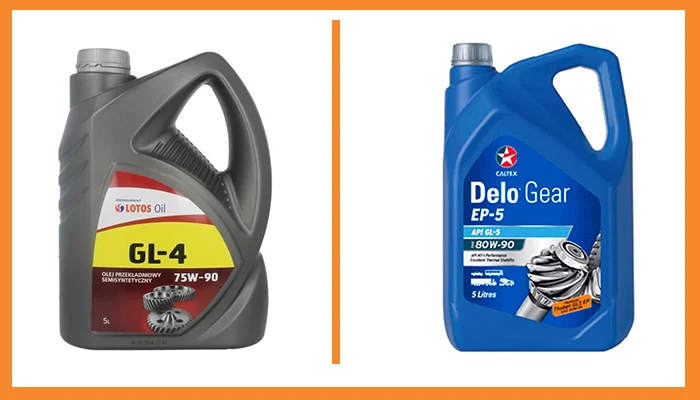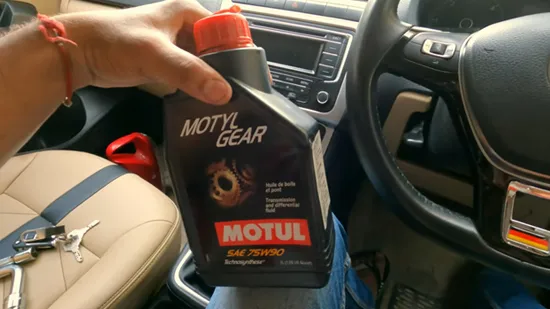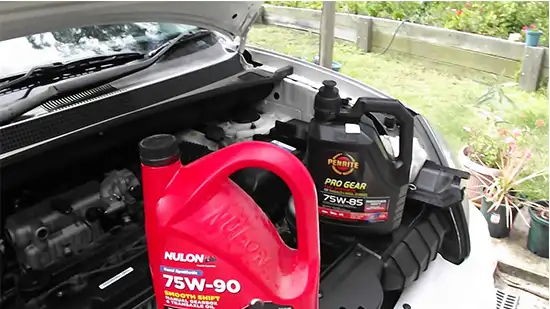Physical Address
304 North Cardinal St.
Dorchester Center, MA 02124
Physical Address
304 North Cardinal St.
Dorchester Center, MA 02124

Gear oil is a crucial component of any vehicle’s transmission system, serving to lubricate gears, reduce friction and wear, and dissipate heat. There are two main types of gear oil available in the market: GL-4 and GL-5. While both serve the same purpose, they have specific differences that affect their suitability for different applications.
According to my research, GL-4 and GL-5 gear oils differ significantly in their extreme pressure additive content. GL-4 gear oil contains up to 4.0% anti-scuffing additive, providing protection against wear for moderate-speed and load applications.
On the other hand, GL-5 contains up to 6.5% anti-scuffing additive and is designed for high-stress, high-speed, and high-load conditions.
Today, I will discuss the differences between GL-4 and GL-5 gear oils and provide insight into which is suitable for different applications.

GL-4 and GL-5 gear oils are two distinct lubricants designed for various applications in the automotive world. Here are six key differences that set them apart.
The role of extreme pressure additives (EPs) in GL4 and GL5 gear oils can help clarify the differences between these oils.
GL4 contains an anti-scuffing additive of up to 4.0%, which forms a sacrificial layer on gear surfaces to reduce wear. These additives have a lower shear strength compared to the metal surfaces they protect, making GL4 suitable for moderate-speed and load applications.
Meanwhile, GL5 gear oil steps up the EP additive game with up to 6.5% anti-scuffing additive. These additives create a robust sacrificial layer with higher shear strength than GL4, making GL5 ideal for high-stress, high-speed, and high-load conditions.
The primary difference between GL4 and GL5 gear oil lies in the level of EP additives, with GL5 containing approximately 50% more EP additives than GL4. This increased concentration allows GL5 to handle extreme pressure situations encountered in high-torque, high-load applications like differentials.
GL4 gear oil is primarily recommended for manual transmissions and transaxles operating at moderate speeds and loads. It’s ideal for vehicles with spur and helical gears, where extreme pressure protection isn’t as critical.
Conversely, GL5 gear oil is specifically designed for high-stress and high-speed conditions, such as those found in automotive axles with hypoid gears. It’s particularly well-suited for heavy-duty applications and powerful vehicles.
The higher level of EP additives in GL5 gear oil provides superior protection against wear, pitting, and scoring, making it more suitable for applications that require extreme pressure resistance.
When selecting a suitable gear oil for your gearbox, it’s crucial to consider the manufacturer’s recommendations and your specific gearbox type.
GL4 gear oil, with fewer EP additives, is generally safe for use in transmissions with yellow metals like brass-bronze alloys. However, it may not provide sufficient protection in high-pressure applications such as differentials.
On the other hand, GL5 gear oil can react aggressively with bronze and copper components, potentially causing damage. This makes it unsuitable for gearboxes that contain these metals unless explicitly permitted by the manufacturer.
You need to consider these compatibility issues when selecting gear oil for your vehicle to prevent unintended wear and damage.
The viscosity of GL4 gear oil is usually lower than that of GL5. This lower viscosity can promote smoother shifting in manual transmissions. However, it’s crucial to select the correct viscosity grade to ensure optimal performance.
On the other hand, GL5 gear oil has higher viscosities, which may impact shifting performance, especially in cold weather conditions. This can lead to less smooth and more challenging shifts.
Therefore, choosing the right viscosity grade is vital in determining the feel and performance of your transmission. GL4 gear oil is available in viscosity grades SAE 80W and SAE 80W-90, while GL5 oil is available in SAE 80W-90 and SAE 85W-140.
EP additives in gear oil create a protective sacrificial layer on gear surfaces to prevent wear and tear. However, the shear strength of these additives varies between GL-4 and GL-5 gear oils.
GL-4 gear oil has EP additives that produce a sacrificial layer with lower shear strength. This low strength is suitable for applications where lower torque is applied, such as manual transmissions.
On the other hand, GL-5 gear oil has EP additives that form a robust sacrificial layer with higher shear strength. This higher strength is essential for withstanding high-torque and high-load conditions, making it ideal for heavy-duty gear applications and differentials.
The capability to handle shock loading is another factor that distinguishes GL-4 and GL-5 gear oils. GL-4 gear oil is not specifically designed to handle shock loading as it focuses on applications with less extreme pressure.
Therefore, it might not be the right choice for situations that require sudden and intense force or torque.
In contrast, GL-5 gear oil is engineered to withstand shock loading, making it perfect for applications that experience sudden and intense force or torque, such as in differentials where wheel forces vary.
| Characteristics | GL-4 Gear Oil | GL-5 Gear Oil |
| EP Additives | Up to 4.0% anti-scuffing additives forming a sacrificial layer. | Up to 6.5% anti-scuffing additives with a stronger sacrificial layer. |
| Applications | Suitable for moderate-speed manual transmissions. | Ideal for high-stress, high-speed axles and differentials. |
| Compatibility | Safer with yellow metals, less protection in high-pressure areas. | Aggressive reaction with bronze/copper components without permission. |
| Viscosity | Lower viscosity, potentially smoother shifting. | Higher viscosity, affecting shifting especially in cold weather. |
| Shear Strength | EP additives have lower shear strength. | EP additives create stronger sacrificial layers, ideal for heavy loads. |
| Shock Loading | Not specifically designed for handling sudden intense force. | Engineered to withstand shock loading, suitable for varying forces. |

Using GL-5 gear oil in a manual transmission that recommends GL-4 is generally not recommended. This is due to the higher EP additives in GL-5 gear oil, which can harm the synchromesh rings in your gearbox. Over time, the use of GL-5 gear oil could potentially cause damage to your transmission.
It’s important to note that unless the manufacturer explicitly permits the use of GL-5 in your transmission, it’s safer to stick with the recommended GL-4 gear oil. GL-4 gear oil is a better choice for transmissions with severe service but without shock loading.
The frequency at which GL-4 and GL-5 gear oils should be changed varies depending on several factors, including driving conditions, vehicle type, and manufacturer’s guidelines.
During my research, I found that gear oil needs to be changed every 10,000 kilometers or every six months, whichever occurs first. However, some vehicles may have longer intervals, such as 20,000 kilometers.
It’s crucial to consult your owner’s manual for the manufacturer’s specific recommendations. For certain vehicles, the guideline is to change the gear oil every 30,000 miles or every 3 years.
In specific cases, particularly for rear differentials, you may extend the interval to 45,000 to 60,000 miles, depending on your driving conditions. Always consider your vehicle’s unique needs and consult the manual for accurate guidance.
Furthermore, keep an eye out for any signs of gear oil leaks, as this can affect the oil change interval and your vehicle’s performance. If you notice a leak, it’s essential to address it promptly to avoid potential damage to your transmission components.

I hope that you can now make an informed decision regarding the choice between GL-4 and GL-5 gear oils for your vehicle’s specific requirements. If you’re looking for a gear oil suitable for moderate-speed, moderate-load applications in manual transmissions, GL-4 might be the better choice due to its lower EP additive content.
On the other hand, if your vehicle requires high-stress, high-speed, or high-load capabilities, especially in differentials, GL-5 gear oil offers superior extreme pressure protection.
Always consult your owner’s manual and consider the manufacturer’s recommendations to ensure optimal performance and longevity of your vehicle’s transmission system.
Last update on 2025-07-12 / Affiliate links / Images from Amazon Product Advertising API